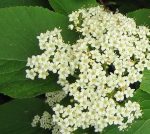 Wayfaring tree is a large deciduous shrub growing up to 15’ tall and wide and a member of the moschatel family, Adoxaceae, that also includes elders (Sambucus). It is native to open woodland and woodland edges in Europe to western Asia but has naturalized in the US and is considered invasive from Maine and Michigan, south to Maryland and Illinois. Plants like full sun to partial shade, and average, moist, well-drained soil but tolerate less.
Wayfaring tree is a large deciduous shrub growing up to 15’ tall and wide and a member of the moschatel family, Adoxaceae, that also includes elders (Sambucus). It is native to open woodland and woodland edges in Europe to western Asia but has naturalized in the US and is considered invasive from Maine and Michigan, south to Maryland and Illinois. Plants like full sun to partial shade, and average, moist, well-drained soil but tolerate less.
Description: The bold dark green leaves are 2-5” long, elliptical to ovate, leathery, thick, and toothed, and have large white conspicuous veins on the underside. Flat-topped clusters of creamy white flowers 3-5” in diameter appear in spring and have a fishy odor. Fruits are green turning to red, red-orange or red-yellow by early late summer but often fail to appear. The plants are vigorous, tend to get leggy, and can become invasive. Several cultivars are available that vary in size and foliage color.
Control: Small plants can be hand pulled and older ones dug out. Removing flowers and/or seed heads before ripening prevents spread. Mowing, cutting, dozing, stick raking and burning can be effective but burning must be followed up with spot spraying and/or mechanical removal. The herbicide glyphosate is marginally effective as a foliar spray, and fluroxypvr and imazapyr have been successfully used as a basal application, but mowing and spraying the freshly cut stumps is the easiest treatment and requires the least herbicide. Triclopyr has also been used effectively as a basal application.